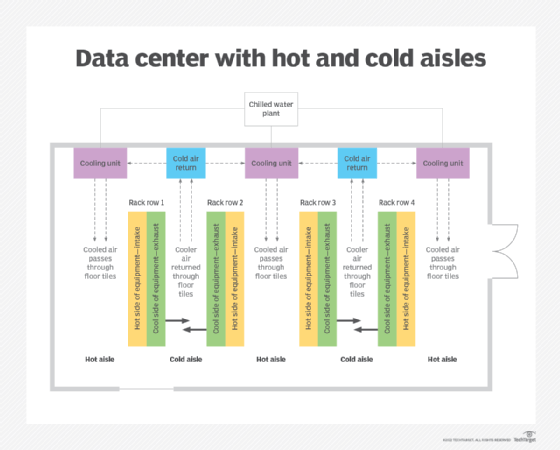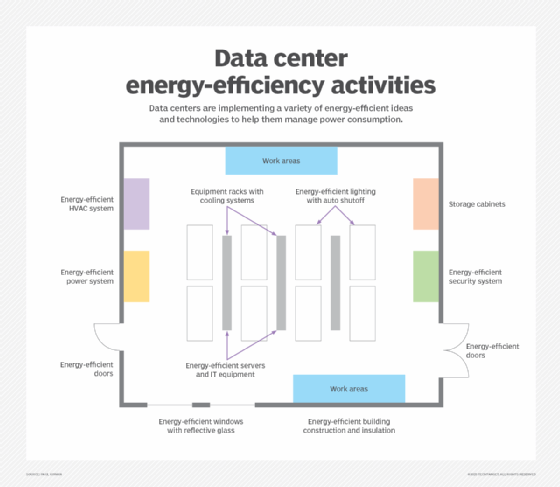Data center cooling systems and technologies and how they work
Extreme heat and cold can keep equipment from operating at peak efficiency. Explore cost-efficient and cost-effective cooling technologies and smart options for your facility.
One of the most vital tasks for any data center is environmental monitoring and management. High temperatures and humidity levels can damage IT equipment, causing them to fail. Such conditions can also lead to uncomfortable conditions for personnel working inside the data center.
Fortunately, many systems and technologies can help monitor and manage data center cooling to keep temperatures and humidity levels in the optimal range.
What is data center cooling?
Data centers use a lot of power, which translates into heat. The more equipment packed into a facility, the greater the heat generated. The term data center cooling refers to the collective equipment, tools, systems, techniques and processes that ensure ideal temperatures and humidity levels within a data center facility. Proper data center cooling ensures an entire facility has enough cooling, ventilation and humidity control to keep all equipment within desired temperature ranges.
Why is data center cooling important?
High temperatures and humidity levels are undesirable conditions for IT and electrical equipment. Most IT devices and equipment produce heat and need to get rid of it quickly so their performance isn't affected. Excess heat and humidity can damage devices and equipment, causing them to malfunction and stop working. Damaged equipment can lead to the risk of fire and other safety issues. These risks increase operational costs, as equipment must be repaired or replaced more frequently.
As most data centers run Class A1 and A2 equipment, facility managers must ensure their cooling systems are up to the task. This need to buy additional or up-to-date equipment to keep up with cooling requirements explains why experts predicted the global cooling market will grow by nearly 14% annually, with the U.S. cooling market reaching $8.24 billion in spending within the next four years.
How does data center cooling work?
Data center cooling removes excess heat from the air and replaces it with cooler air. This is typically done in one of several ways:
- Venting hot air outside and bringing outside air in, cooling it and circulating it in the facility.
- Recycling internal air by cooling it, usually through a hot and cold aisle design to maximize cooling efficiency.
- Venting hot air outside and then drawing pre-chilled outside air into the facility to cool it down. This approach is known as free cooling, and it only works for facilities in colder climates.
- Cooling or heating the facility to the highest recommended temperature and replacing equipment once it fails. Using this so-called heat cooling or close-coupled cooling method can be cheaper, as other cooling methods might cost significantly more than equipment replacement costs.
Current data center cooling systems and technologies
Air cooling and liquid cooling are two of the most popular types of data center cooling.
Air cooling
This cooling method is ideal for smaller or older data centers that combine raised floors with hot and cold aisle designs. When the computer room AC (CRAC) unit or computer room air handler (CRAH) sends out cold air, the pressure below the raised floor increases and sends the cold air into the equipment inlets. The cold air displaces the hot air, which is then returned to the CRAC or CRAH, where it's cooled and recirculated.
Hot and cold air aisles increase the efficiency of air-based cooling systems by enabling more targeted placement of intake and exhaust vents. This prevents hot and cold air mixing so the cooling CRAC or CRAH can work more efficiently.
Also, a CRAH is more efficient than a CRAC, as it draws outside air in and cools it using chilled water instead of refrigerant. A CRAC functions like a residential AC unit that uses refrigerants to cool the air. CRAC units are more appropriate for small data center closets because they can't keep up with enterprise-level data centers.
Hot and cold aisle layouts
In this layout, server cabinets and racks are arranged in a row pattern, with each row facing the opposite direction to the one in front of it.
This equipment configuration has cold intake and hot air vents facing each other, creating alternating aisles of hot and cold air. CRAHs in each aisle either vent or pump in air so the cooling system works efficiently. Hot air is vented from the hot aisle, and cool air is pumped through the cold aisle.
Doors and walls can be added to the layout to further direct airflow. Cabinets should be as full as possible to avoid empty spaces, gaps and cable openings that can leak hot or cold air into the opposite aisle, causing the cooling system to work overtime.

Liquid cooling
A relatively newer technology is liquid cooling. It's a more efficient and cost-effective cooling system because it can be installed on data center devices that need it the most. Liquid is more efficient than air at transferring heat away from emitting sources. It can also support greater equipment densities and items that generate higher-than-average heat, such as high-density and edge-computing data centers.
There are two main types of liquid cooling:
- Liquid immersion cooling. This method places the entire electrical device into dielectric fluid in a closed system. The fluid absorbs the heat emitted by the device, turns it into vapor and condenses it, helping the device to cool down.
- Direct-to-chip liquid cooling. This method uses flexible tubes to bring nonflammable dielectric fluid directly to the processing chip or motherboard component generating the most heat, such as the CPU or GPU. The fluid absorbs the heat by turning it into vapor, which carries the heat out of the equipment through the same tube.
Importance of energy efficiency in data center cooling
Cooling systems should be part of a data center's overall energy-efficiency strategy. According to the latest stats, these systems typically consume a significant amount of the facility's energy consumption -- up to 33%. And with most facilities spending 50% of their operating expenses on energy bills, cooling is a good place to focus efficiency improvements.
Ensuring a state of good repair of the facility infrastructure, such as HVAC and power systems, is a good first start. Next, operators can look at the IT hardware they use to confirm it's always working optimally. Replacement and sunsetting processes can help by introducing more modern, efficient technologies as needed.
Exploring new cooling technologies is another way to manage energy efficiency. New and evolved technologies, such as free cooling and liquid cooling systems, can greatly reduce cooling needs and increase energy consumption efficiency across the facility.

Future data center cooling systems and technologies
Although liquid cooling is still relatively new, other data center cooling technologies are on the horizon, such as geothermal cooling methods, smart technologies that use AI and machine learning to better monitor and manage cooling, and evaporative cooling.
Using nature to cool data centers
Here are some ways data centers can use nature to cool their facilities:
- Geothermal cooling uses the near-constant temperature of the Earth below surface level to provide cooling. It's a centuries-old idea, once used to keep food cold, adapted to our modern era. In data centers, geothermal cooling uses a closed-loop pipe system with water or another coolant that runs through vertical wells underground, filled with a heat-transferring liquid. Iron Mountain's western Pennsylvania data center, Verne Global in Iceland and Green Mountain in Norway use geothermal cooling for their data centers.
- Evaporative cooling, or swamp cooling, takes advantage of the drop in temperature that occurs when water is exposed to moving air and begins to vaporize and change to a gas. A fan draws warm data center air through a water- or coolant-moistened pad, and as the liquid evaporates, the air is chilled and pushed back into the data center. It can cost a fraction of an air-cooled HVAC system and works best in low-humidity climates.
- Solar cooling converts heat from the sun into cooling that can be used in data center air cooling systems. The system collects solar power and uses a thermally driven cooling process to decrease the air temperature in a building. This is useful in areas with a lot of sunlight or for data centers looking to supplement their current cooling with a more environmentally friendly method.
- Kyoto Cooling is an enhancement of the free cooling method that uses a thermal wheel to control hot and cold airflows across the data center. Internal hot air is vented to the outside as the wheel rotates; the outside air then cools the wheel and the air that is drawn back into the facility. It uses between 75% to 92% less power to run than other CRAH systems, reduces carbon dioxide emissions and eliminates the need for water in the cooling system. The technology is used by United Airlines' data center outside of Chicago and HP in its data center outside of Toronto.
Using smart technology for data center cooling
Because many of the newer data center cooling technologies require significant investment by facility owners, smart technology has become popular. Data center smart assistants, AI and machine learning technologies can monitor facilities more efficiently and make real-time adjustments to ensure optimal temperatures and humidity levels. Google, for example, uses smart temperature controls to reduce heat output and cooling usage. The company has also used its DeepMind AI product to reduce cooling energy use by 40% in 18 months.
Data center cooling robots can move within the facility, monitoring temperatures and humidity levels in specific server cabinets. One challenge with monitoring temperatures in cabinets manually is that conditions change as soon as they're opened. Companies such as OneNeck IT Solutions have developed a robot sensor probe that fits into standard cabinets. The robot moves up and down a belt-driven rail inside the cabinet to collect temperature data for each rack. It then transmits the data via Bluetooth to connected devices so data center pros can create a full heat map of the cabinet.
Data center demand will only increase, so facility owners and their customers must look at more efficient and cost-effective cooling solutions -- whether it's less environmentally harmful options, such as geothermal and free cooling, or investing in newer technologies, such as liquid immersion cooling for high-powered servers.
Editor's note: This article was originally published in 2022 and was updated by the author in 2024 to include more recent considerations for data center cooling technologies.
Julia Borgini is a freelance technical copywriter, content marketer, content strategist and geek. She writes about B2B tech, SaaS, DevOps, the cloud and other tech topics.







